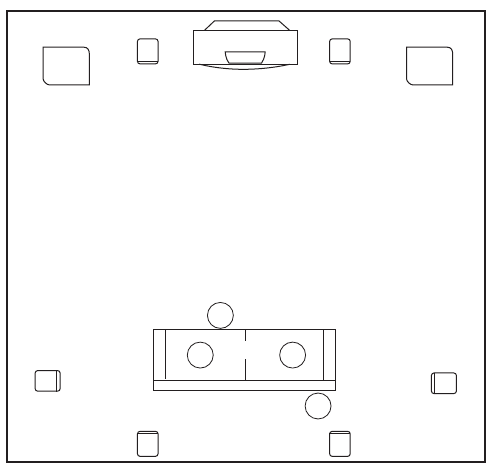
10
Once you have connected the sub-
woofer input into the JBL BassQ unit
and connected the outputs from the unit
to all subwoofers in the system, you will
need to run the BassQ test to finalize
the room calibration and correction.
Before You Begin
It is very important that all subwoofers
are on and installed before you run the
BassQ process. If you move a sub-
woofer or add a sub to the system, you
will need to rerun the test. Set all initial
settings on all attached subwoofers or
subwoofer amplifiers to nominal or 0dB
input level (phase set to 0°) and bypass
all internal crossovers.
If Your System Includes an AV2
Before beginning any calibration, select
BASSQ ->Yes from the AV2 Setup menu.
This will optimize the delay settings and
AV2 Autocal for use with the JBL BassQ
processor. It will be necessary to manu-
ally set the subwoofer output level from
the AV2 processor. See the AV2 manual
for details.
Step One: Microphone Setup
Begin the calibration process by setting
up the microphone array to test the
listening area. The JBL BassQ unit
includes four microphones, four micro-
phone bases and eight microphone
stands. Begin by screwing together
two stands to make four tall stands.
Press the poles firmly into the base.
The hole in the base will securely hold
the stand, but you should make sure
that the stand is in the base before pro-
ceeding. Next, screw one microphone
each into the top of the stand. Each
microphone comes with an attached
cable with a 1/4" jack on the end. Plug
each microphone into the front of the
JBL BassQ unit, using the diagram
below as a reference for placement.
It is important that the microphones
cover the listening area.
Step Two: Turn On All Electronics
Make sure that all electronics are on,
including all subwoofers or subwoofer
amplifiers. Turn down or mute the vol-
ume on the preamp.
NOTE: Many self-powered subwoofers,
such as the PS1400 and HTPS-400, have
auto turn-on based on signal sensing.
Either turn them to
On or make sure
that they are on and remain on for this
test. If the subwoofers are not already
on, the first part of the test tone will be
clipped and BassQ will not properly
calibrate the room.
Step Three: Begin the BassQ Process
The first time you power up the JBL
BassQ unit, the blue light will be off and
the unit will be in Bypass mode. Press
the BassQ button. The BassQ light will
begin to blink, indicating that it has
started the process. You will hear a test
tone from each subwoofer, one at a
time. When the process is finished,
the BassQ light will be solid and the
subwoofer lights will flash briefly to
indicate which outputs have subwoofers
attached and are calibrated. You can
confirm which outputs are calibrated by
placing the unit into Standby mode and
then on again. The lights will go on briefly
to indicate which outputs are active.
NOTE: When using an AV2, it is important
to run the Autocal only after using the
BassQ process and setting the BassQ
setting to
Yes in the AV2 setup menu.
See the AV2 manual for details.
Step Four: Level Calibration of
Main Speakers
Level adjustments are best done using
an SPL meter that is set to C-weighting
and Slow response. Set the level control
on your subwoofer to 0dB or a nominal
reference level. Turn on the internal
noise test from the AV1 (or other
processor) and, using the level control
in your preamp or processor, set all
speaker levels to a 75dB reference
level. If using the AV2 Autocal, the levels
will automatically be set. Be sure to set
the AV2 to
Yes for BassQ in the AV2
setup menu.
Step Five: Distance Calibration
Due to the different distances between
the listening position for the subwoofer,
the front channel speakers and the sur-
round speakers, the amount of time it
takes for sound to reach your ears from
front speakers versus surround speakers
differs. You may compensate for this
difference through the use of the delay
settings to adjust the timing for the
speaker placement and acoustic
conditions in your listening room or
home theater. Begin by measuring
the distance between your listening
position and each of the speakers in
your system. Write these down, as you
may need to remember them in the
future. If you have more than one
subwoofer, it is best to place them
an equal distance from the listening
position. If this is not possible, use the
distance from the closest subwoofer
for the speaker distance settings. If
using the AV2 Autocal, the distances
will automatically be set. Be sure to
set the AV2 to
Yes for BassQ in the AV2
setup menu.
Step Six: Enjoy the Music
You can now disconnect all the micro-
phones and pack up the stands. Keep
these, in case you need to rerun the
test. Unmute the preamp and enjoy.
CALIBRATION AND ROOM MODE CORRECTION
Left Rear
Surround Channel
Left
Surround
Channel
Right
Surround
Channel
Right Rear
Surround Channel
Left Front
Channel
Subwoofer
Subwoofer
Right Front
Channel
Center
Channel
Couch
1 2
4
3
JBLP2338 BassQ 5/8/08 4:54 PM Page 10














